Mixing old and new furniture gives your home a sense of history, as if it’s evolved naturally over the years instead of being assembled from a single catalog. This approach adds personality and depth, making your space feel truly yours.
Remember to repin your favorite images!
When you get it right, this blend transforms ordinary rooms into layered, story-filled spaces. Your home starts to feel like a reflection of your life, not just a collection of things.
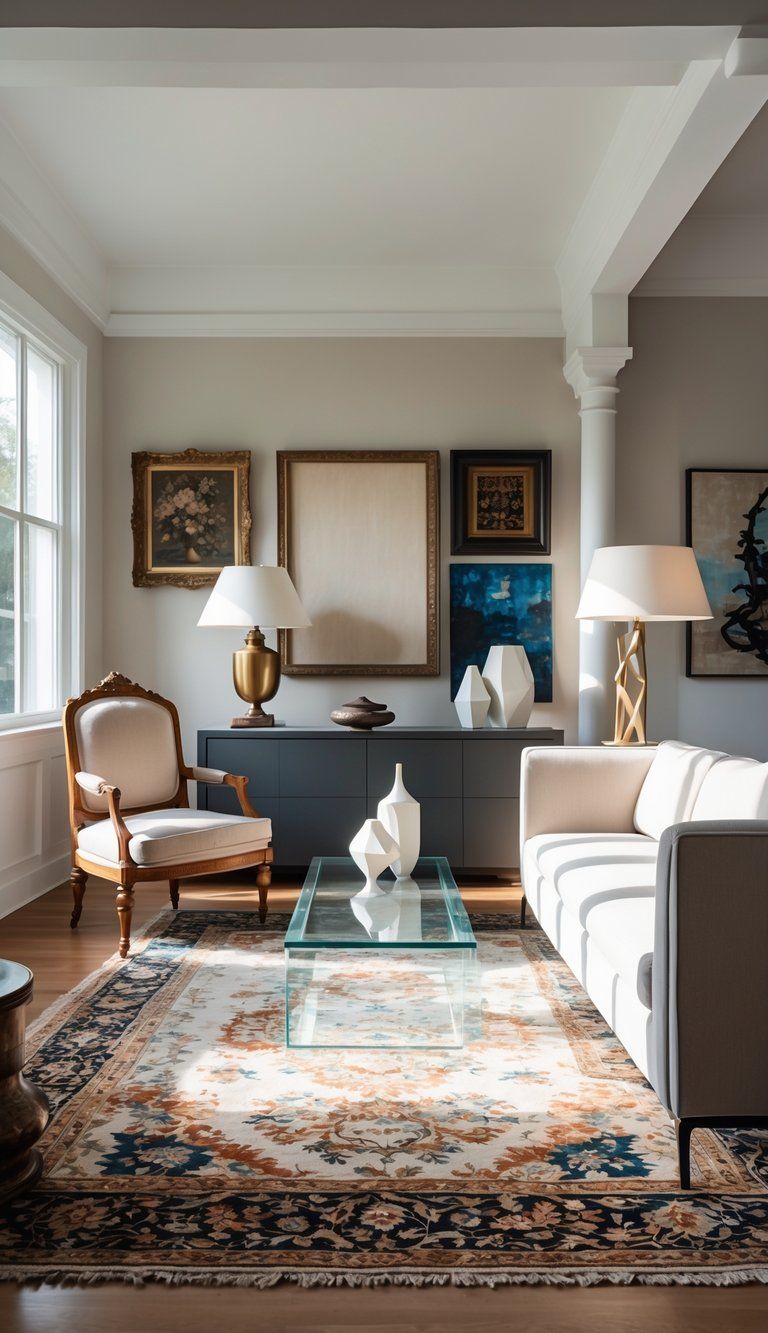
Blending furniture styles well means picking a few standout pieces for each room. Place those special items against simpler backdrops, and suddenly everything just clicks. Maybe you’ve paired a modern marble dining table with vintage chairs, or tucked a mid-century console under a classic painting—those thoughtful combinations really elevate a space.
This approach breaks up the monotony of matching sets and keeps things visually interesting. Your home should evolve with you, collecting pieces from different moments in your life. The best spaces often mix something old with history and something new that brings in fresh energy.
The Art and Impact of Blending Old and New
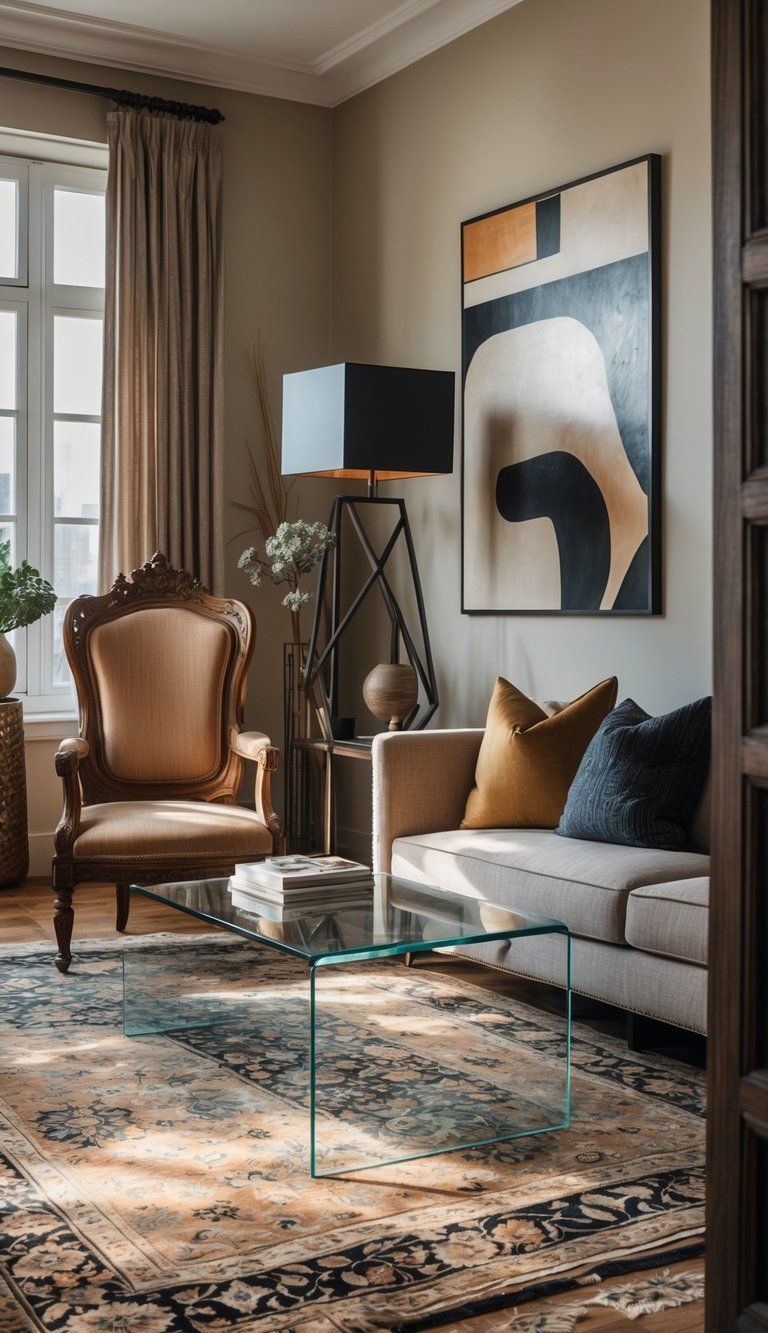
When you mix furniture from different eras, your space starts to feel more authentic and curated. The right blend of vintage charm and modern practicality lets you express your personal style while your rooms change with you.
Understanding the Principles of Mixing Styles
To mix styles successfully, look for common threads that tie everything together. Color is probably your strongest tool here.
If your vintage and modern pieces share a color palette, they just naturally feel more connected. Scale and proportion matter too. A massive antique armoire can actually balance out a sleek modern sofa if their visual weight lines up.
Try to stick to a main style for about 70% of the room, and use the other 30% for accents. Materials help bridge the gap between eras as well.
Wood tones can link a traditional table to modern chairs, and metal finishes on vintage lamps can echo the legs of a new side table. Prioritize quality over age—well-made pieces always complement each other.
Benefits of Combining Vintage and Modern Pieces
When you mix old and new furniture, your home feels collected over time, not just purchased in one go. This gives your space a sense of authenticity and avoids that impersonal “catalog” look.
Vintage pieces bring in character, history, and often better craftsmanship. Modern items add clean lines and practical features.
Together, they create a dynamic tension that keeps things interesting. You also get more flexibility with your budget.
Maybe you splurge on a vintage statement piece, then fill in with affordable modern finds. Plus, it’s more sustainable—using existing furniture cuts down on waste and still lets you enjoy current trends.
Mixing eras makes your space unique. It ends up telling your personal story, not just following a single design moment.
Finding Visual Balance in an Eclectic Space
Start with a neutral foundation. Keep your walls, floors, and big furniture pieces calm so both old and new can stand out.
Let your pieces “talk” to each other instead of separating styles by room. A vintage chair can work right next to a modern side table if they serve a purpose together.
Textiles help tie everything together. Pillows, throws, and rugs can pull in colors from both antique and contemporary pieces.
Lighting can make or break a mixed-style room. A modern pendant brings energy to a classic dining set, while vintage lamps warm up sleek seating areas.
Think about how each piece makes you feel. The best eclectic spaces bring together items that mean something to you, no matter their age.
Defining Vintage and Modern Furniture Styles
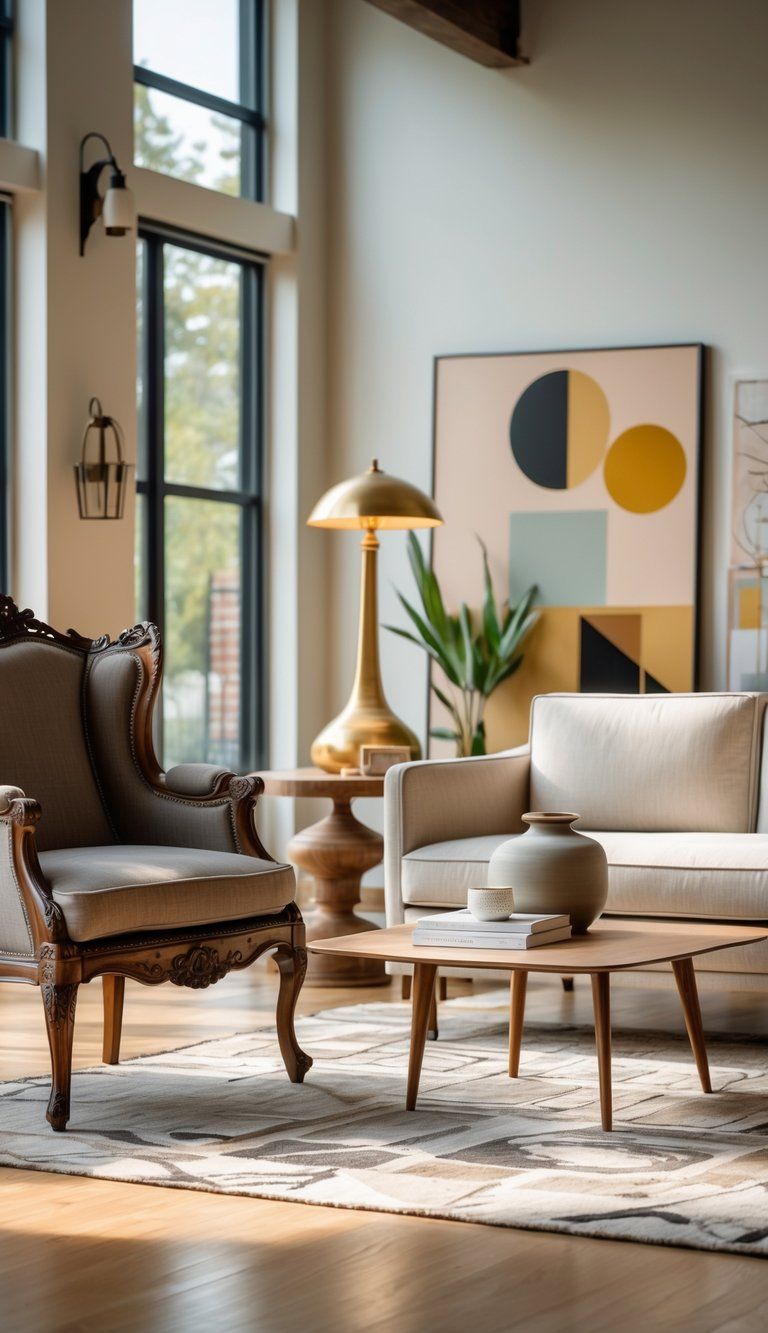
Knowing the difference between furniture styles helps you create balanced, interesting rooms. Understanding what makes something vintage or modern will guide your choices and help you avoid mistakes.
What Qualifies as Vintage, Antique, and Modern
Furniture gets classified by age. Antique pieces are usually 100 years old or more, so anything from before 1925 counts as antique now.
These tend to show off serious craftsmanship and historical value. Vintage furniture falls between 20 and 100 years old.
That means furniture from the 1930s to early 2000s is considered vintage in 2025. Mid-century modern (1940s-1970s) and Art Deco (1920s-1930s) are especially popular vintage styles.
Modern furniture technically refers to the modernist movement (1920s-1970s), which focused on clean lines and simplicity. But let’s be real—most people use “modern” to mean anything current.
Contemporary furniture covers stuff made in the last 20 years or still in production. These pieces reflect today’s trends and technology.
Common Characteristics of Vintage and Antique Pieces
Vintage and antique furniture often show off unique craftsmanship. Hand-carved details and old-school joinery like dovetail joints signal an older piece.
Materials can give away a piece’s age too. Look for solid wood construction (usually heavier), original brass or iron hardware, and upholstery made from natural materials like horsehair or wool.
You’ll spot a rich patina on older pieces. Vintage styles have their own signatures.
Art Deco is all about bold geometry, exotic woods, and mirrored surfaces. Mid-century modern leans on organic shapes, tapered legs, and functional design.
Older furniture often features more ornate details—think scrollwork, inlays, and carving—compared to today’s streamlined look.
Recognizing Modern and Contemporary Furniture
Modern and contemporary furniture focus on simplicity and function. These pieces usually have clean lines, minimal decoration, and use materials like metal, glass, and engineered wood.
Manufacturing sets newer pieces apart. You’ll see CNC machining for precise cuts, modular designs, mass production, and innovative materials like plastic polymers and metal alloys.
Contemporary furniture often builds in tech and sustainability. Things like USB charging, modular parts, and eco-friendly materials are common.
Current trends include multifunctional furniture (like storage ottomans), floating pieces (wall-mounted shelves), and mixed materials (wood with metal accents). Comfort and ergonomics usually come first, with style following close behind.
How to Start Mixing Old and New Furniture
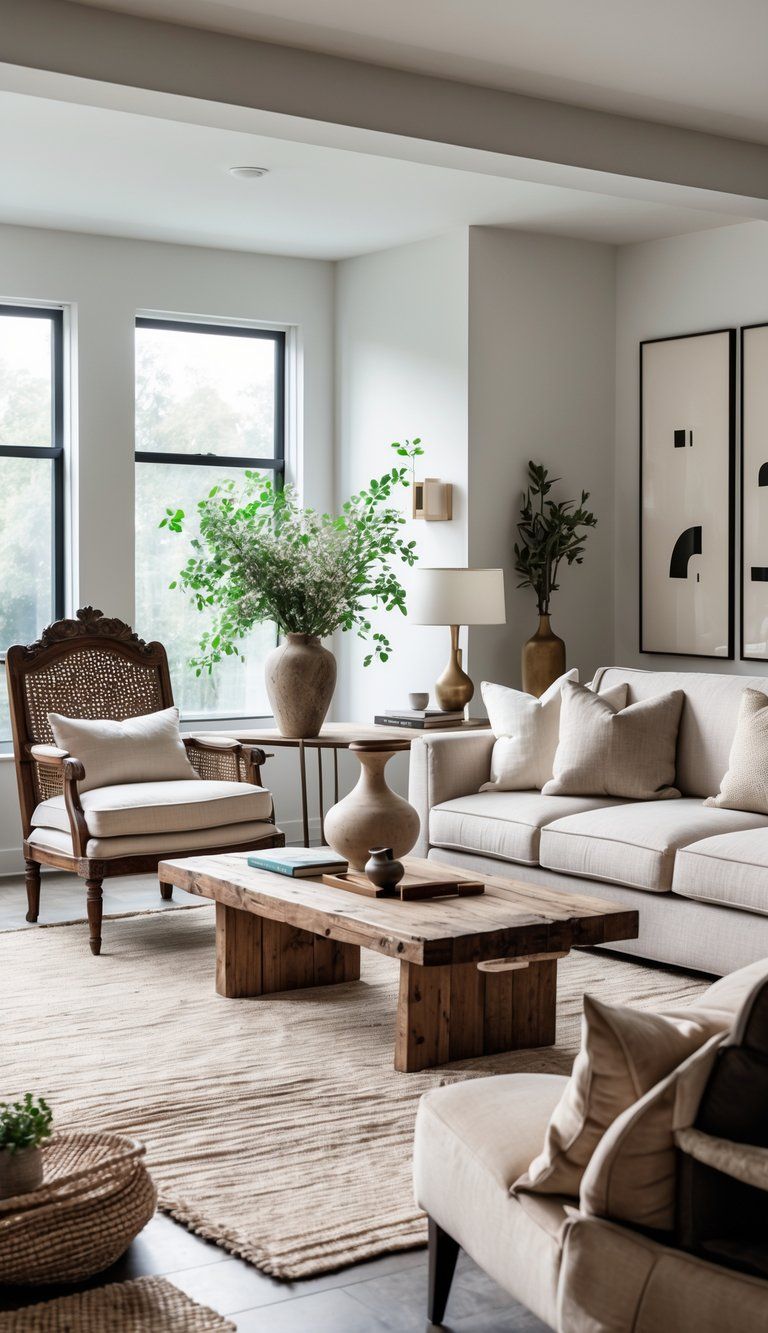
Blending vintage and modern pieces takes a little planning. Start with a clear idea of what you want, then build your space step by step, always looking for harmony between styles.
Setting a Cohesive Color Scheme
A unified color palette helps bridge old and new. Pick two or three main colors to repeat throughout the room.
This keeps things consistent, even if the styles are different. Wood tones matter too.
Try to find overlap—maybe your modern coffee table and vintage bookcase both have warm oak finishes. Paint can also unify mismatched pieces.
A vintage chair looks fresh with a coat of color that matches your modern sofa. This works well for wood furniture that isn’t museum-worthy.
Textiles like pillows and rugs help pull your palette together. Use them to introduce accent colors that pop up in both old and new pieces.
Selecting a Signature Statement Piece
Every mixed room needs a focal point. Pick one standout item—vintage or modern—to anchor the space.
Maybe it’s an ornate antique dresser, a bold modern painting, or a unique mid-century chair. Place your statement piece where it naturally grabs attention.
Balance is everything. If you go big with a vintage cabinet, keep the modern elements simpler.
Some ideas: Lay a vintage Persian rug under modern furniture, hang an antique chandelier over a contemporary dining table, or pair a sleek sofa with vintage side tables.
Assessing Proportions, Scale, and Placement
Pay attention to how your pieces relate in size. A delicate antique desk can get lost next to a huge modern sectional.
Arrange furniture thoughtfully. Try placing older pieces on one wall, newer ones opposite, and see how your eye moves across the room.
Take photos of different layouts—it really helps you spot what works. Keep these tips in mind:
Pair bulky vintage pieces with slim modern ones. Balance tall antiques with low-profile contemporary furniture.
Give ornate older pieces some breathing room. Don’t feel like you need to fill every corner.
Sometimes, a single vintage chair in open space gives off the perfect modern-classic vibe.
Creating Visual Interest Through Contrast and Texture
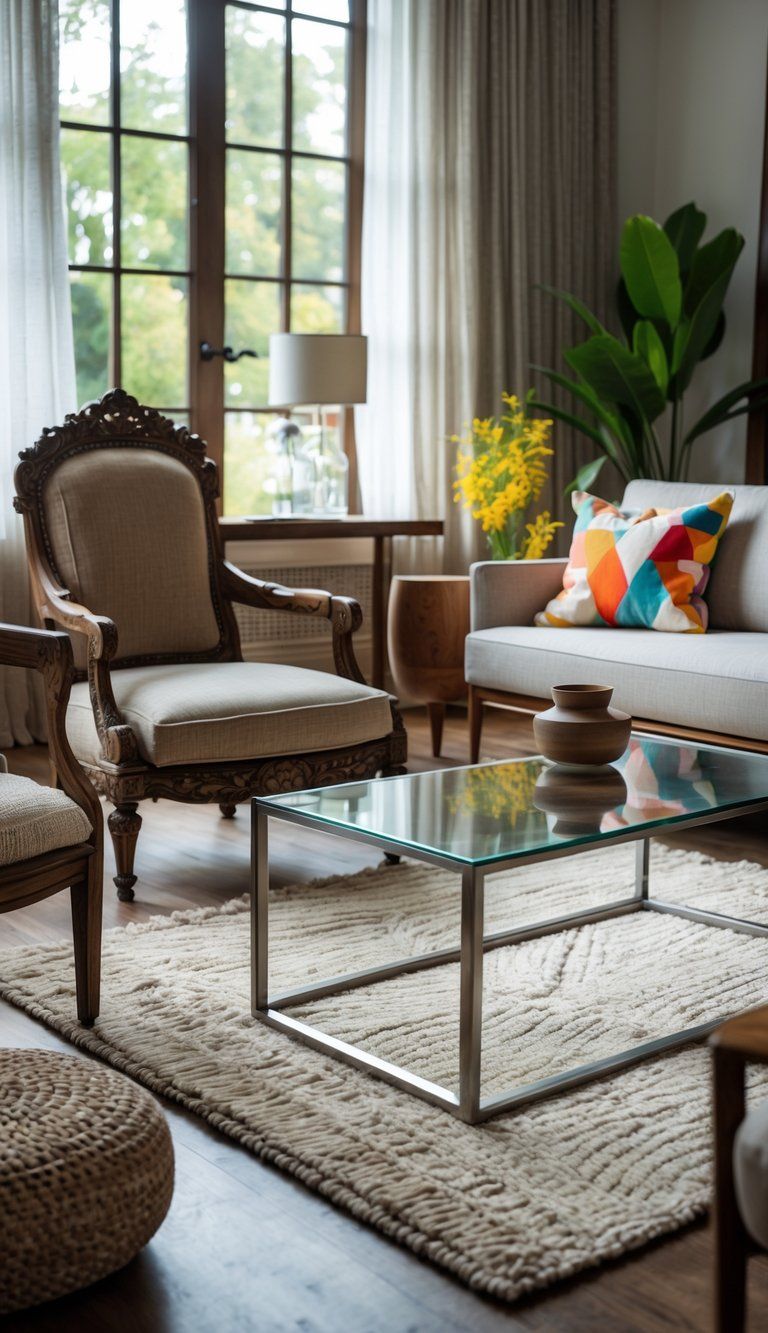
The real magic of mixing old and new furniture comes from how you create visual interest. The right mix of textures, contrasts, and accessories can totally transform a room.
Layering Textures and Materials
Texture is your secret weapon for blending styles. Start by checking out the main textures you already have.
If your vintage sofa’s all about smooth velvet, maybe add a modern coffee table in rough wood or brushed metal. Some great combos:
- Smooth + Rough: Polished marble with distressed wood
- Hard + Soft: Metal furniture with plush textiles
- Matte + Glossy: Matte-finished vintage pieces with shiny modern accents
Layer in textiles like pillows and throws. A modern sofa feels more at home with an antique chair if they share a texture, like linen or wool.
Try mixing in unexpected materials too—rattan, glass, leather, even concrete can spark fun conversations between old and new.
Using Contrast With Patterns and Colors
Color and pattern help your eye move between different furniture styles. Sometimes, a bold color can tie everything together.
Try these ideas:
- Pick one bold color to link different pieces
- Use a neutral backdrop for furniture from different eras
- Follow the 60-30-10 rule: 60% main color, 30% secondary, 10% accent
Balance patterns carefully. If your vintage armchair has a busy floral, keep your modern pieces in solids or subtle geometrics.
Color temperature matters, too. Warm wood tones from antiques can look great with cool-toned modern accessories, creating just the right amount of visual tension.
Incorporating Accessories for Depth
Accessories finish off your space and make mixed furniture styles look intentional, not accidental. Art especially does a great job bridging different eras.
Think about these accessory ideas:
- Art placement: Hang modern art above vintage furniture, or flip the script.
- Lighting: Place a contemporary lamp on an antique side table.
- Books and objects: Mix vintage and modern decorative items together.
Scale really matters with accessories. Large statement pieces pull focus, while clusters of smaller things add interest at different heights.
Try creating little vignettes that mix old and new. Maybe a vintage tray with a few modern ceramics—it draws the eye and says something about your style.
Showcasing Character and Storytelling in Your Design
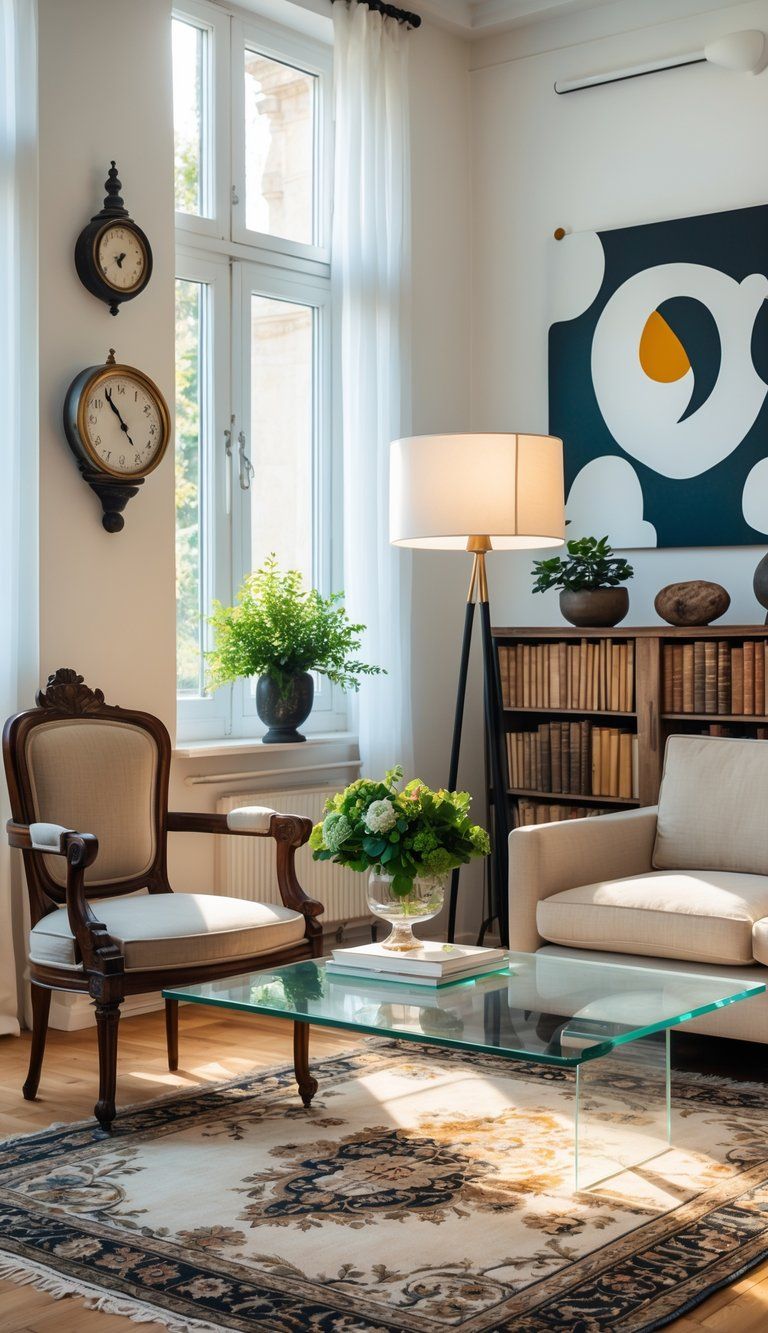
Your furniture choices really do tell your story. When you mix old and new pieces with care, you end up with spaces that reflect your personality and experiences.
Highlighting Craftsmanship and Artisanal Details
Handcrafted furniture brings real soul to a room. Look for visible joinery, hand-carved details, or traditional techniques you just can’t get from a machine.
A handwoven rug or a hand-thrown ceramic vase adds texture and depth, and honestly, mass-produced stuff just can’t compete. These pieces often become instant conversation starters.
Put artisanal pieces where people will notice them. A handcrafted wooden coffee table can anchor your living room, while hand-forged cabinet hardware gives your kitchen a subtle but memorable twist.
Look for these craftsmanship details:
- Dovetail joints in drawers
- Hand-applied finishes
- Visible tool marks
- Natural material quirks
- Maker’s signatures or stamps
Adding Family Heirlooms with Personal Meaning
Family heirlooms really connect your space to your story. That lamp from your grandmother? It’s more than lighting—it’s a piece of your history.
You don’t have to keep heirlooms exactly as they were. Reupholster an antique chair in a modern fabric to respect its bones but keep it relevant for today.
Display meaningful items where they’ll get noticed. Your grandfather’s writing desk could become your home office centerpiece, and vintage photos in modern frames liven up your walls.
Choose heirlooms that resonate with you and work with your design. Too many, and it starts feeling like a museum.
Curating Collections of Art and Vintage Décor
Curated collections add so much personality. Whether it’s vintage cameras, old maps, or modern prints, your collections show off your interests.
Group things together for impact. A wall of botanical prints or a shelf full of vintage pottery makes a statement that scattered pieces just can’t.
Mix eras and styles in your collections. A contemporary painting next to a vintage photo creates a nice bit of tension and keeps things interesting.
Ideas for displaying collections:
- Floating shelves for 3D objects
- Gallery walls for art
- Rotate in seasonal pieces to keep things fresh
- Group by color, theme, or material
- Leave some breathing room to avoid clutter
Editing is key. Go for quality over quantity so each piece gets its chance to shine.
Room-by-Room Strategies for Mixing Old and New
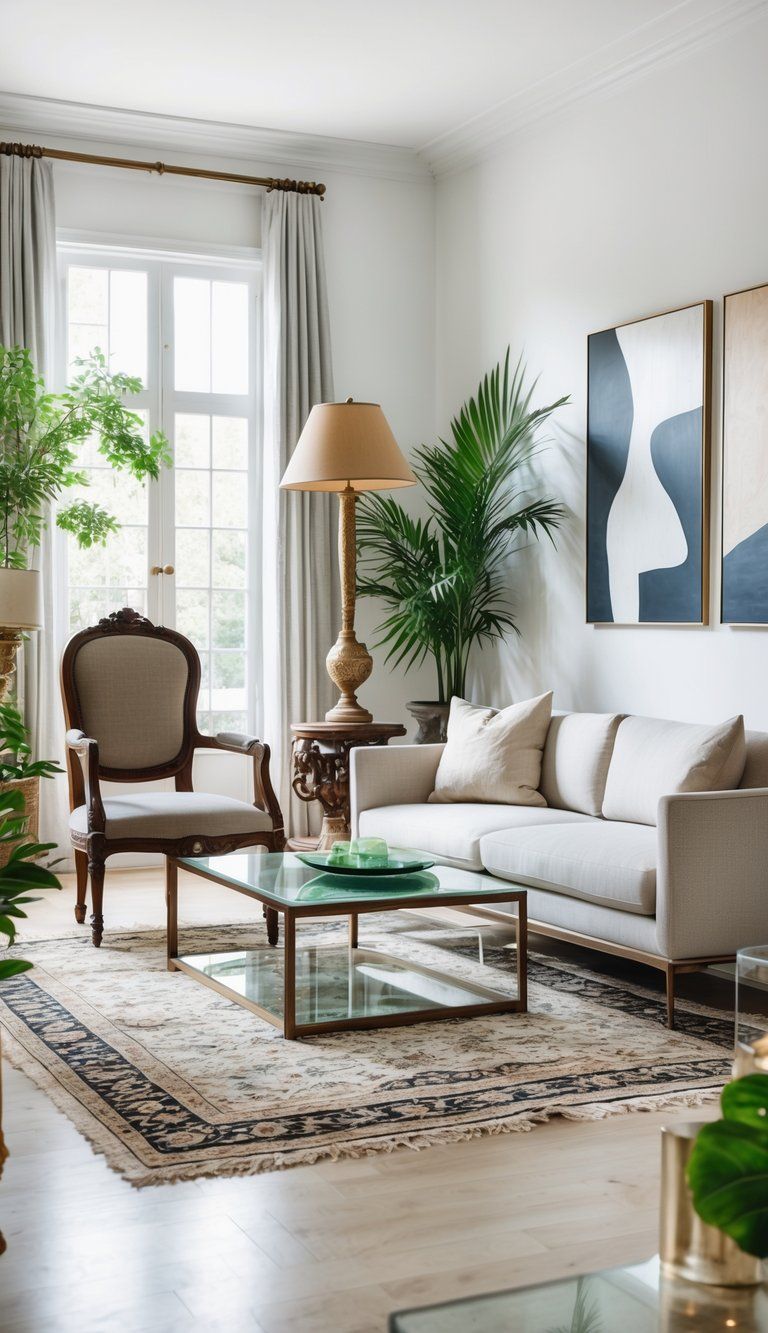
Every room in your home gives you a new chance to blend vintage charm with modern function. The trick is figuring out how each space can show off this mix while still doing its job.
Living Room: Creating Focal Points
The living room is a great spot to mix periods. Start with one standout piece—maybe a vintage sofa with modern fabric or an antique coffee table next to contemporary chairs.
Balance matters. If you’ve got an ornate antique cabinet, keep the nearby items simple and modern so nothing has to fight for attention.
Mix up your conversation areas. A mid-century armchair can sit across from a new sofa if they share colors or textures.
Lighting is an easy way to blend styles. Try a modern floor lamp with a vintage table lamp, or hang a sleek pendant above an antique side table.
Quick Tip: Use art to bridge old and new. A contemporary painting above a traditional console can look amazing.
Bedroom: Balancing Comfort With Style
Comfort should always come first in the bedroom. A vintage bed frame can be the centerpiece, especially with crisp modern bedding.
Nightstands don’t have to match. Try an antique table on one side and a modern piece on the other. The imbalance keeps things interesting and still works.
Lighting sets the mood. Mix a vintage chandelier with simple contemporary bedside lamps for cozy, balanced light.
Storage is another spot to mix things up. A modern wardrobe can pair nicely with a vintage dresser if they share a wood tone or hardware style.
Watch the scale, especially in small bedrooms. Bulky antiques can take over, so go for slimmer vintage pieces or pair them with minimalist modern furniture.
Kitchen: Incorporating Vintage Details in Modern Spaces
Modern kitchens really come alive with thoughtful vintage touches. Open shelves with heirloom dishware or antique cooking tools add warmth to sleek cabinets.
Think of hardware as the jewelry of your kitchen. Vintage knobs and pulls can totally transform modern cabinets, especially if they’ve got a nice patina.
Seating is an easy way to mix styles. Vintage bar stools or a refurbished farm table with modern chairs make any kitchen feel inviting.
Lighting makes a big difference. Try industrial vintage pendants over a modern island, or set a retro lamp on a contemporary counter.
Materials matter: Use vintage elements for texture. A reclaimed wood accent wall or antique brick backsplash warms up a kitchen full of modern finishes.
Selecting and Placing Statement Pieces
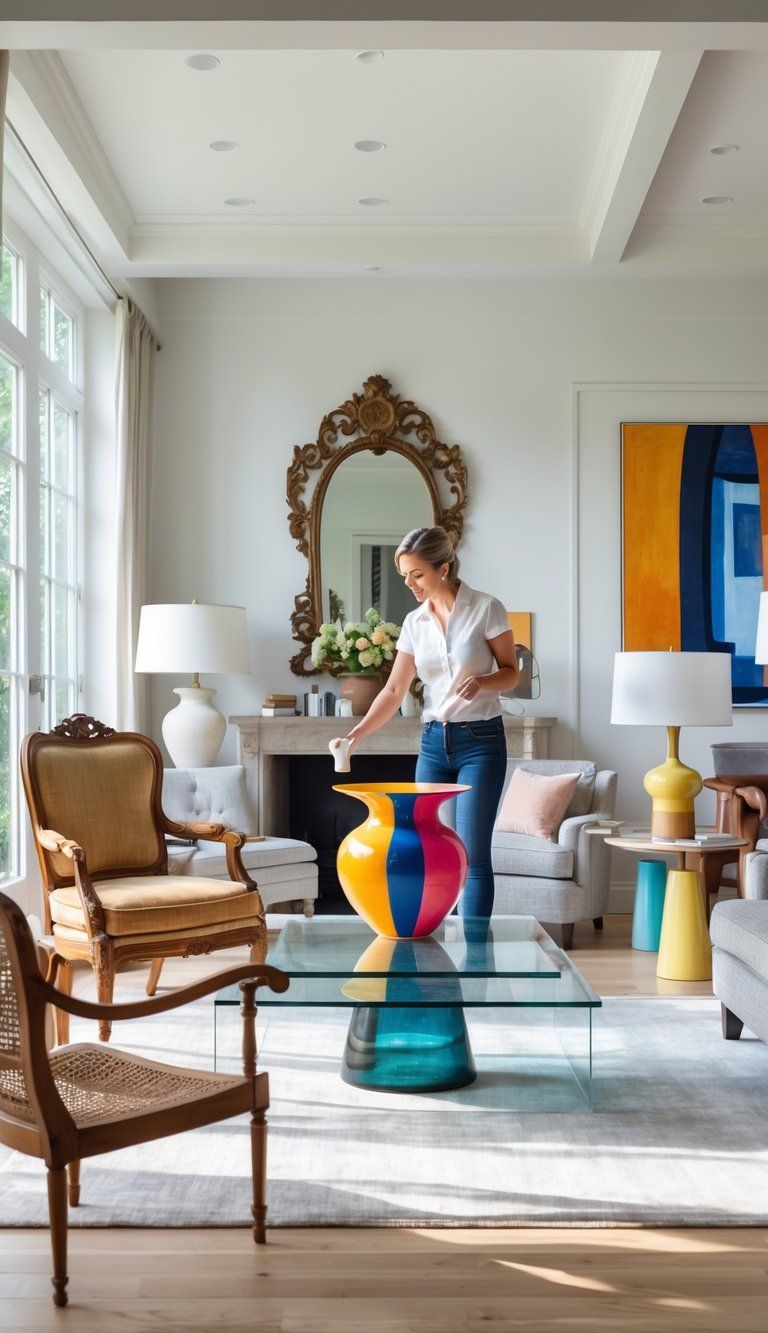
Statement pieces pull a room together and help old and new styles make sense together. When you pick them carefully, these standout items can anchor your space and make everything else feel cohesive.
Tips for Sourcing Unique Vintage Pieces
Skip the big furniture stores and hunt for vintage statement pieces at flea markets, estate sales, or online spots like Etsy. Always check the condition and think about any restoration costs before you buy.
Measure your space before bringing home something vintage. That gorgeous antique cabinet might look perfect in the shop but could totally overwhelm your room.
Focus on quality craftsmanship and unique details you won’t find in new furniture. Dovetail joints, hand-carved bits, and original hardware add real authenticity.
Don’t ignore pieces with a little history. They spark conversation and bring personality to your space.
Integrating Bold Modern Elements
Balance vintage finds with modern elements for a bit of visual tension. Maybe a sleek sofa with antique side tables, or a minimalist dining table with vintage chairs.
Bold colors work great for modern statement pieces. A bright accent chair or vivid artwork can energize a room full of neutral vintage things.
Scale is important. Large-scale modern art can complement ornate vintage furniture without fighting for attention.
Look for modern pieces with clean lines to contrast with vintage details. This keeps things interesting but not chaotic.
Lighting, Accessories, and Finishing Touches
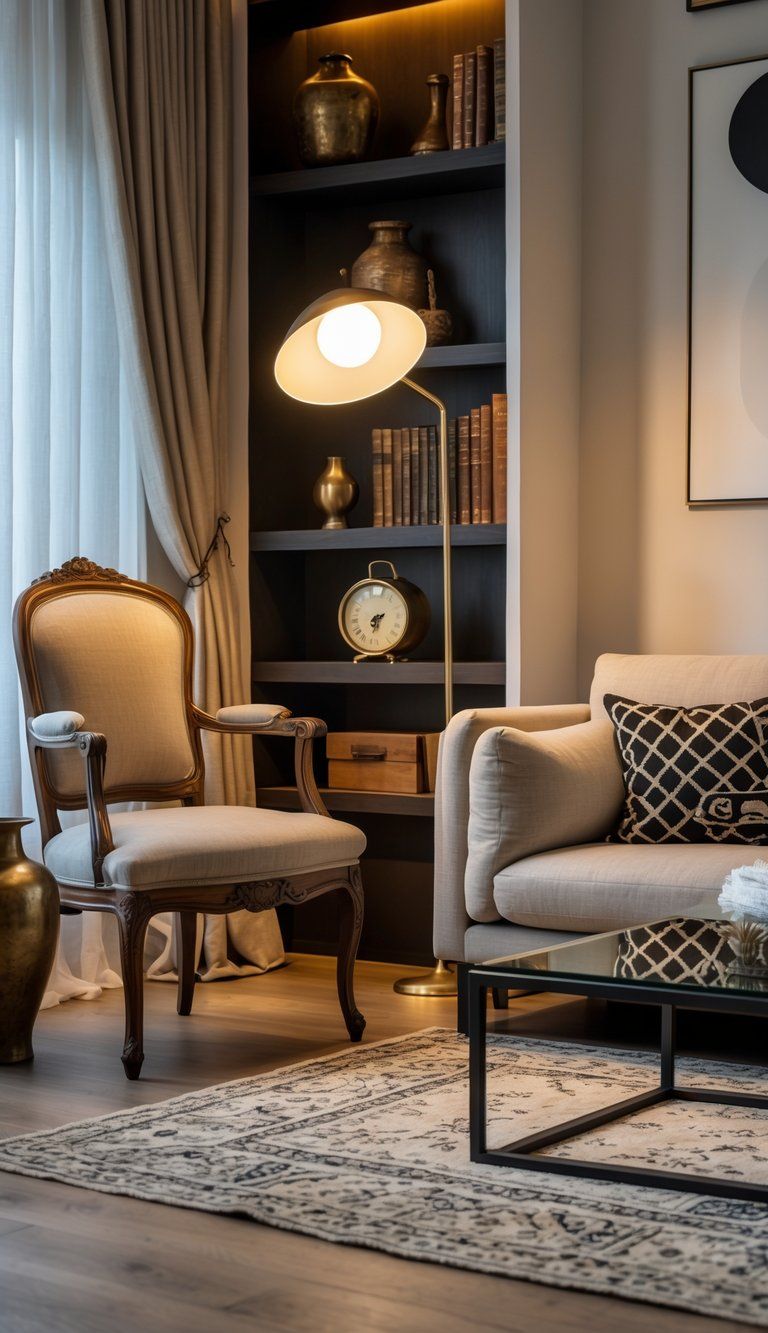
The right lighting and accessories really tie together vintage and modern pieces. They add those personal touches that make a space feel finished and uniquely yours.
Choosing Lighting That Bridges Styles
Lighting does more than just light up a room—it sets the mood and connects different eras. A modern chandelier over a vintage dining table creates a cool contrast. Try a sleek floor lamp next to an antique side table for balance.
Try these lighting options to blend styles:
- Statement pendants: Modern glass or metal pendants look great with traditional furniture.
- Vintage table lamps: Warm up a contemporary space.
- Adjustable wall sconces: Work well in both modern and classic rooms.
Layer your lighting at different heights for more depth. Use warm bulbs (2700-3000K) to keep things cozy and flattering.
Accessorizing With Artwork and Décor
Accessories and art are the finishing touches that bring a mixed-style room to life. They help connect different furniture eras and add your personal story.
Pick accessories that work with both vintage and modern pieces:
- Books and objects in colors that pop up elsewhere in the room
- Mirrors to reflect your arrangements and bounce around light
- Plants to soften modern edges and highlight vintage charm
Artwork is key for blending styles. Try traditional paintings in modern frames, or hang contemporary prints above antique furniture. This creates a bit of tension and makes the space feel curated.
Mix up textures—rough ceramics, smooth glass, woven baskets—to add depth and keep things interesting. Stick to a consistent color palette to help everything feel unified.
Consulting With Design Professionals
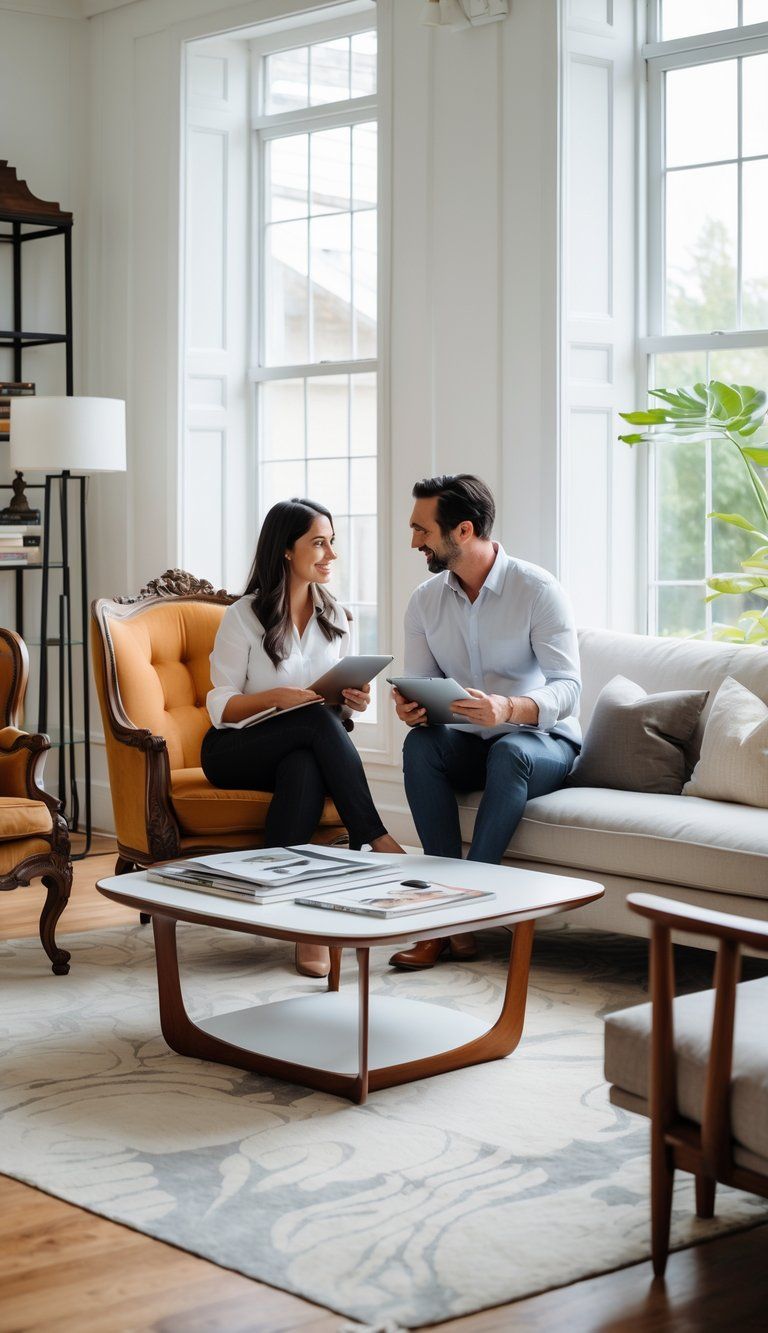
Sometimes, mixing old and new furniture just gets tricky. That’s when design pros can step in and help create a balanced look that feels just right.
When to Hire an Expert
Think about hiring a design professional if you feel overwhelmed or can’t quite picture the end result. Designers like Artem Kropovinsky from Arsight in New York know how to blend different styles and eras into standout rooms.
A designer comes in handy if you:
- Own valuable antiques
- Need help matching colors or textures
- Feel stuck on arranging your space
- Want to avoid expensive mistakes
Professional help is especially worth it if you’re combining important pieces or working on high-traffic rooms. Designers bring fresh eyes and spot opportunities you might miss.
What to Expect From a Design Consultation
At your first meeting, be ready to talk about your vision, budget, and timeline. A good designer will ask about your lifestyle and how you use the space before suggesting anything.
Most consultations cover:
- Your style preferences
- What furniture you already have
- Ideas for new pieces
- Thoughts on placement and layout
- Color and texture suggestions
The designer will probably come up with a plan that uses texture and color to tie your old and new pieces together. They focus on making the space feel cohesive, not random.
Bring photos of furniture you love and rooms that inspire you. It helps your designer get your vibe and create a home that’s both personal and professional.
Conclusion: Embracing Individuality in Modern Living
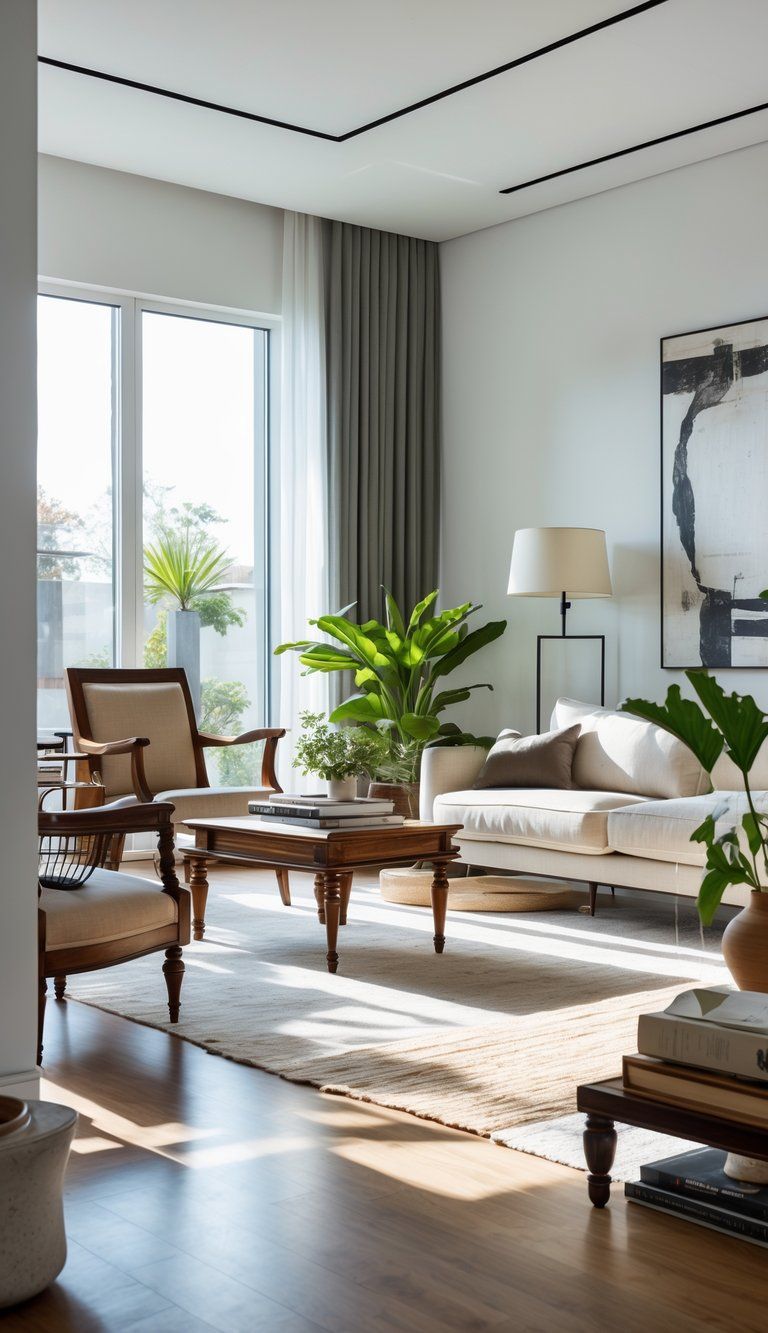
Mixing old and new furniture isn’t just about design—it’s a way to tell your story. Your space should feel like you, full of memories and moments.
When you pull together different eras and styles, you end up with a home that’s unmistakably yours. Cookie-cutter designs just can’t compete with that kind of personality.
Modern life asks us to stay flexible. Your home can change right along with you, making room for new finds while holding on to what matters.
Honestly, breaking the so-called “rules” can make your space way more interesting. Sometimes the best rooms come from combos that seem a little weird at first.
A few things to keep in mind:
- Trust your instincts – If it feels right, go for it.
- Quality matters – Pick pieces you actually love.
- Balance is key – Try mixing bold with subtle, or ornate with simple.
- Tell your story – Let each item mean something to you.
Your home isn’t a museum or a showroom—it’s a living, breathing place that changes as you do. Let it grow with you.
The real magic in mixing old and new? You get a timeless environment that never feels stuck in one era. It’s authentic, personal, and, honestly, that’s exactly what a home should be.

